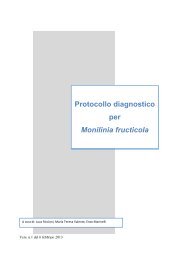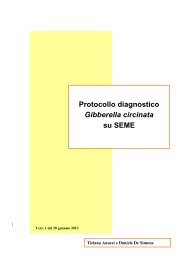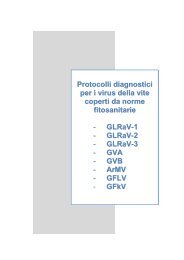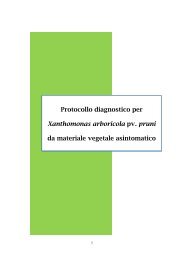Faggioli et al. Workshop 2012.pdf - Strateco
Faggioli et al. Workshop 2012.pdf - Strateco
Faggioli et al. Workshop 2012.pdf - Strateco
You also want an ePaper? Increase the reach of your titles
YUMPU automatically turns print PDFs into web optimized ePapers that Google loves.
p<strong>et</strong>ria -<strong>Workshop</strong> ancona 2012 “Difesa ortive Da seme”<br />
IMPORTANZA DELLA DIAGNOSI SU SEME DI POMODORO<br />
PER L’IDENTIFICAZIONE DI ALCUNI AGENTI INFETTIVI<br />
“Seed-bORne”<br />
F. <strong>Faggioli</strong>, S. Lor<strong>et</strong>i, L. Tomassoli<br />
CRA-PAV, Centro di Ricerca per la Patologia Veg<strong>et</strong><strong>al</strong>e<br />
Via C.G. Bertero, 22, I-00156 Roma<br />
E-mail: laura.tomassoli@entecra.it<br />
Un elevato numero di specie ortive è colpito da patogeni sistemici, che<br />
possono colonizzare o raggiungere, attraverso i tessuti vascolari, anche gli organi<br />
riproduttivi della pianta e, conseguentemente, i frutti e i semi che da essi derivano.<br />
Per questo motivo le sementi possono rappresentare un rischio fitosanitario per la<br />
diffusione delle m<strong>al</strong>attie sistemiche a lunga, da un paese ad un <strong>al</strong>tro, e a breve, da<br />
un ciclo veg<strong>et</strong>ativo <strong>al</strong> successivo, distanza. Tra i patogeni sistemici del pomodoro<br />
(Solanum lycopersicon) si annoverano diversi organismi da quarantena che sono in<br />
grado di inf<strong>et</strong>tarne il seme e trasm<strong>et</strong>tere l’infezione <strong>al</strong>la piantina da esso germogliata.<br />
Fra i patogeni batterici, sulla semente di pomodoro sono previsti controlli per<br />
Clavibacter michiganensis subsp. michiganensis (Cmm) e Xanthomonas campestris<br />
pv. vesicatoria (sin X. axonopodis pv. vesicatoria) (Xav), entrambi segn<strong>al</strong>ati nella<br />
lista A2 dell’EPPO. Studi sulla trasmissibilità di Cmm attraverso il seme hanno<br />
verificato non più dell’1% di trasmissione della m<strong>al</strong>attia (Grogan e Kendrick, 1953).<br />
La contaminazione della semente da Xav può avvenire durante l’estrazione del seme<br />
da bacche inf<strong>et</strong>te, ed è riportato che il batterio può sopravvivere fino a 10 anni in semi<br />
di pomodoro (Bashan <strong>et</strong> <strong>al</strong>., 1982). Entrambe le m<strong>al</strong>attie sono ubiquitarie per la coltura<br />
del pomodoro ma spesso i focolai d’infezione sono d<strong>et</strong>erminati d<strong>al</strong>la diffusione di<br />
sementi inf<strong>et</strong>te. E’ quanto accaduto nell’estate 2010, quando semente inf<strong>et</strong>ta da Cmm<br />
è stata interc<strong>et</strong>tata solo dopo la già avvenuta distribuzione, e nuovi casi di cancro<br />
batterico si sono verificati in Puglia e Basilicata (Fanigliulo <strong>et</strong> <strong>al</strong>., 2010) e in seguito<br />
in <strong>al</strong>tre regioni it<strong>al</strong>iane. I protocolli diagnostici specifici per le an<strong>al</strong>isi su seme sono<br />
riportati d<strong>al</strong>l’EPPO, d<strong>al</strong>l’Internation<strong>al</strong> Seed Federation (ISF) e sono disponibili kit<br />
sierologici commerci<strong>al</strong>i. Il protocollo di diagnosi di Cmm è in questo momento in<br />
fase di revisione da parte dell’EPPO, ed è in corso di v<strong>al</strong>idazione a livello nazion<strong>al</strong>e<br />
(Prog<strong>et</strong>to nazion<strong>al</strong>e MIPAAF: ARNADIA).<br />
Altri due agenti patogeni sistemici qu<strong>al</strong>i Pepino mosaic virus (PepMV) e Potato<br />
spindle tuber viroid (PSTVd) hanno assunto un’elevata importanza fitosanitaria per la<br />
semente di pomodoro. Sebbene la percentu<strong>al</strong>e di trasmissione per seme sia piuttosto<br />
bassa, c<strong>al</strong>colata pari <strong>al</strong>lo 0,057% per PepMV (Hanssen <strong>et</strong> <strong>al</strong>., 2010) e accertata in pochi<br />
e circoscritti esperimenti per PSTVd (Singh, 1970; Kryczynski <strong>et</strong> <strong>al</strong>., 1988), la capacità<br />
dei due agenti inf<strong>et</strong>tivi di causare infezione anche per semplice contatto d<strong>et</strong>ermina<br />
un’<strong>al</strong>ta probabilità di diffusione della m<strong>al</strong>attia nel corso delle operazioni coltur<strong>al</strong>i,<br />
80
P<strong>et</strong>ria 22 (2), 65-122 (2012) -<strong>Workshop</strong> ancona 2012 “Difesa ortive Da seme”<br />
anche con sorgente di inoculo costituita da poche piantine. PepMV è stato identificato<br />
in Europa nel 2000 (Van der Vlugt <strong>et</strong> <strong>al</strong>., 2000) e si è rapidamente diffuso in molti<br />
paesi. Il sosp<strong>et</strong>to inizi<strong>al</strong>e che il seme fosse una via di trasmissione è stato provato da<br />
numerose ricerche. Per t<strong>al</strong>e motivo, la Decisione Europea 2004/200/EU ha imposto il<br />
divi<strong>et</strong>o di introduzione da paesi terzi e circolazione tra i paesi comunitari di semente di<br />
pomodoro inf<strong>et</strong>ta d<strong>al</strong> virus, rendendo obbligatorio il passaporto fitosanitario. Diversi<br />
protocolli diagnostici specifici per le an<strong>al</strong>isi su seme di pomodoro sono forniti da<br />
Ditte commerci<strong>al</strong>i per kit sierologici, o d<strong>al</strong>l’ISF ma soprattutto protocolli diagnostici<br />
sierologici e molecolari sono stati v<strong>al</strong>idati sia a livello europeo (Prog<strong>et</strong>to: PEPEIRA)<br />
che nazion<strong>al</strong>e (Prog<strong>et</strong>to MIPAAF: ARNADIA).<br />
Diversa è la situazione riguardo il PSTVd, organismo da quarantena presente<br />
nell’<strong>al</strong>legato I/A1 della Dir<strong>et</strong>tiva 2000/29/EC. Questo viroide è stato inizi<strong>al</strong>mente<br />
studiato su patata e tutte le normative fitosanitarie originariamente si riferivano a<br />
questa specie. Recentemente però, le infezioni accertate su ornament<strong>al</strong>i e i casi di<br />
focolai su pomodoro, gli hanno conferito una maggiore importanza e pericolosità in<br />
molti paesi. Specificatamente, dopo le prime segn<strong>al</strong>azioni su Solanum jasminoides<br />
e pomodoro (Verhoeven <strong>et</strong> <strong>al</strong>., 2006, 2008; Di Serio, 2007; Navarro <strong>et</strong> <strong>al</strong>., 2009),<br />
il mondo scientifico si è particolarmente attivato per aumentare le conoscenze<br />
epidemiologiche, biologiche e diagnostiche per le nuove combinazioni ospite/PSTVd<br />
(prog<strong>et</strong>to EUPHRESCO e bando Floricoltura MIPAAF: PSTVd-free). In particolare,<br />
la voce “seme pomodoro” rappresenta una delle linee di ricerca princip<strong>al</strong>i su cui<br />
investigare per ottenere dati certi sul ruolo del seme nella diffusione e, quindi, definire<br />
i param<strong>et</strong>ri per un buon campionamento e una diagnosi sensibile. A questo proposito,<br />
nel 2012 ha preso il via un EUPHRESCO di cui l’It<strong>al</strong>ia fa parte con il CRA-PAV.<br />
Non tutti i paesi da cui l’It<strong>al</strong>ia importa seme di pomodoro appaiono trasparenti o<br />
attivi in materia fitosanitaria. Risulta difficile, infatti, ottenere dati certi in l<strong>et</strong>teratura<br />
sulla presenza o meno, in questi paesi, dei patogeni illustrati. Pertanto, in attesa<br />
di ulteriori sviluppi sia della ricerca che degli asp<strong>et</strong>ti legislativi, si auspica un <strong>al</strong>to<br />
livello di guardia nei controlli delle sementi di pomodoro <strong>al</strong> fine di ridurre il rischio di<br />
diffusione ed endemizzazione di questi patogeni in It<strong>al</strong>ia.<br />
Parole chiave: Cmm, PepMV, Pomodoro, PSTVd, Semente, Xav.<br />
Importance of routine diagnosis for systemic pathogens on<br />
tomato seeds<br />
A large number of crops are affected by systemic pathogens that can colonize<br />
the reproductive organs as well as the fruits and seeds. For this reason, seeds can<br />
pose risks regarding the movement and introduction of a pest from one country to<br />
another, and from one cultivation area to another. Therefore, different veg<strong>et</strong>able<br />
species are subject to internation<strong>al</strong> and nation<strong>al</strong> regulations that impose controls on<br />
seeds. Specific<strong>al</strong>ly, tomato (Solanum lycopersicum) seed mark<strong>et</strong>ing (certification of<br />
81
p<strong>et</strong>ria -<strong>Workshop</strong> ancona 2012 “Difesa ortive Da seme”<br />
pathogen-free materi<strong>al</strong>s) is regulated by European Directives against two bacteria:<br />
Clavibacter michiganensis subsp. michiganensis (Cmm) and Xanthomonas campestris<br />
pv. vesicatoria (syn. X. axonopodis pv. vesicatoria), (Xav) that are included in the<br />
EPPO A2 list of quarantine organisms. Cmm seed transmission has been investigated,<br />
ascertaining not more than 1% of disease transmission (Grogan and Kendrick, 1953).<br />
Xav seed contamination gener<strong>al</strong>ly occurs during seed extraction from infected berries,<br />
and this bacterium can survive on tomato seeds for periods of at least 10 years (Bashan<br />
<strong>et</strong> <strong>al</strong>., 1982). Both diseases are ubiquitous for growing tomatoes, and new outbreaks<br />
are often caused by infected seed as the inoculum source. Since summer 2010, new<br />
outbreaks of tomato canker (Cmm) have been recorded in Apulia and Basilicata<br />
(Fanigliulo <strong>et</strong> <strong>al</strong>., 2010), and more recently in other It<strong>al</strong>ian regions, as consequence<br />
of the previous distribution of infected tomato seeds. Specific diagnostic protocols for<br />
seed an<strong>al</strong>ysis have been reported by EPPO, the Internation<strong>al</strong> Seed Federation (ISF),<br />
and commerci<strong>al</strong> serologic<strong>al</strong> kits are available. Furthermore, the Cmm diagnostic<br />
protocol is currently under review by the EPPO, and its v<strong>al</strong>idation is in progress at a<br />
nation<strong>al</strong> level (nation<strong>al</strong> MIPAAF Project: ARNADIA).<br />
Two other systemic pathogens, Pepino mosaic virus (PepMV) and Potato<br />
spindle tuber viroid (PSTVd) have assumed high importance for tomato seeds. Both<br />
pathogens can <strong>al</strong>so infect tomato seeds, and have the potenti<strong>al</strong> to infect the emergent<br />
plantl<strong>et</strong>s. The PepMV seed transmission rate has been c<strong>al</strong>culated at around 0.057%<br />
(Hanssen <strong>et</strong> <strong>al</strong>., 2010), while PSTVd seed transmission has been investigated in few<br />
experiments (Singh, 1970; Kryczynski <strong>et</strong> <strong>al</strong>., 1988); both of these pathogens can be<br />
transmitted by contact, so from a few infected seedlings, the disease can spread rapidly<br />
throughout a field. PepMV was first identified in Europe in 2000 (Van der Vlugt <strong>et</strong><br />
<strong>al</strong>., 2000), and then suddenly spread to many countries. European Decision 2004/200/<br />
EU imposed a ban on the introduction of tomato seeds infected by PepMV from Third<br />
World countries, and their circulation among the EU countries. Specific diagnostic<br />
protocols for PepMV d<strong>et</strong>ection on tomato seeds are available and are provided by<br />
companies that produce serologic<strong>al</strong> kits, or by the ISF; in particular, serologic<strong>al</strong> and<br />
molecular diagnostic protocols have been v<strong>al</strong>idated both at European (European<br />
project: PEPEIRA) and nation<strong>al</strong> levels (MIPAAF Project: ARNADIA).<br />
PSTVd is a quarantine pathogen that is included in list I/A1 of Directive<br />
2000/29/EC. This viroid was initi<strong>al</strong>ly studied in potato, and origin<strong>al</strong>ly <strong>al</strong>l of the<br />
phytosanitary regulations referred to this species. Recently, infection on ornament<strong>al</strong><br />
plants and cases of outbreaks on tomato have promoted greater concern for PSTVd.<br />
Specific<strong>al</strong>ly, after the first reports of PSTVd on Solanum jasminoides and tomato<br />
in Europe and It<strong>al</strong>y (Verhoeven <strong>et</strong> <strong>al</strong>., 2006, 2008; Di Serio 2007; Navarro <strong>et</strong> <strong>al</strong>.,<br />
2009), scientists have improved the knowledge of the epidemiologic<strong>al</strong>, biologic<strong>al</strong> and<br />
diagnostic aspects of new host-PSTVd combinations (EUPHRESCO and MiPAAF<br />
projects). In the light of the foregoing, the ‘tomato seed’ question represents one of<br />
the main research lines for investigation, because unlike PepMV, there are no reliable<br />
data on the role of seed dissemination and on the actu<strong>al</strong> percentage of seed infection,<br />
and therefore it is not possible to define the param<strong>et</strong>ers for good sampling and for<br />
82
P<strong>et</strong>ria 22 (2), 65-122 (2012) -<strong>Workshop</strong> ancona 2012 “Difesa ortive Da seme”<br />
the d<strong>et</strong>ermination of the sensitivity of diagnostic m<strong>et</strong>hods for the identification of<br />
PSTVd directly in batches of seeds. In this regard, in 2012, the European project<br />
EUPHRESCO was started, in which It<strong>al</strong>y (through CRA-PAV) is taking part.<br />
It should be stressed that not <strong>al</strong>l of the countries from which It<strong>al</strong>y imports<br />
tomato seeds are active in plant he<strong>al</strong>th, and it is difficult to obtain reliable data on the<br />
presence or absence of those pathogens in tomato growing areas. Therefore, pending<br />
further developments in research and legislative matters, it is suggested that a high<br />
level of vigilance be maintained in the control of tomato seeds, to reduce the risk of<br />
the spread of these pathogens in It<strong>al</strong>y.<br />
Key words: Cmm, PepMV, PSTVd, Tomato seeds, Xav.<br />
Lavori citati/References<br />
bashan y., s. Diab, y. okon, 1982. Surviv<strong>al</strong> of Xanthomonas campestris pv.<br />
vesicatoria in pepper seeds and roots, in symptomless and dry leaves in nonhost<br />
plants and in the soil. Plant and Soil, 68, 161-170.<br />
Di serio f., 2007. Identification and characterization of Potato spindle tuber viroid<br />
infecting Solanum jasminoides and S. rantonn<strong>et</strong>ii in It<strong>al</strong>y. Journ<strong>al</strong> of Plant<br />
Pathology, 89, 297-300.<br />
fanigliulo a., a. viggiano, g. piegari, a. crescenzi, 2011. Serious outbreak of<br />
Clavibacter michiganensis subsp. michiganensis on tomato in Southern It<strong>al</strong>y.<br />
Acta Horticulturae, 914, 43-46.<br />
grogan r.g., J.b. kenDrick, 1953. Seed transmission, mode of overwintering and<br />
spread of bacteri<strong>al</strong> canker of tomato caused by Corynebacterium michiganense.<br />
Phytopathology, 43, 473.<br />
hanssen i. m., r. mumforD, D.r. blystaD, i. cortez, b. hasióW-JaroszeWska,<br />
D. hristova, i. pagán, a.m. pereira, J. p<strong>et</strong>ers, h. pospieszny, m. ravnikar,<br />
i. stiJger, l.tomassoli, c. varveri, r. van Der vlugt, s. l. nielsen, 2010.<br />
Seed transmission of Pepino mosaic virus in tomato. European Journ<strong>al</strong> of<br />
Plant Pathology, 126, 145-152.<br />
kryczynski s., e. paDuch-cich<strong>al</strong>, l.J. skrzeczkoWski, 1988. Transmission of three<br />
viroids through seed and pollen of tomato plants. Journ<strong>al</strong> of Phytopathology,<br />
121, 51-57.<br />
navarro b., m.r. sill<strong>et</strong>ti, v.n. trisciuzzi, f. Di serio, 2009. Identification and<br />
characterization of Potato spindle tuber viroid infecting tomato in It<strong>al</strong>y. Journ<strong>al</strong><br />
of Plant Pathology, 91, 723-726.<br />
singh r.p., 1970. Seed transmission of potato spindle tuber virus in tomato and potato.<br />
American Potato Journ<strong>al</strong>, 47, 225-227<br />
van Der vlugt r.r.a., c.c.m. stiJger, J.t.J. verhoeven, D.e. lesemann, 2000.<br />
First report of Pepino mosaic virus on tomato. Plant Disease, 84, 103.<br />
verhoeven J.t.J., c.c.c. Jansen, J.W. roenhorst, 2006. First report of Potato virus<br />
M and Chrysanthemum stunt viroid in Solanum jasminoides. Plant Disease,<br />
90, 1359.<br />
83
p<strong>et</strong>ria -<strong>Workshop</strong> ancona 2012 “Difesa ortive Da seme”<br />
verhoeven J.t.J., c.c.c. Jansen, J.W. roenhorst, 2008. First report of pospiviroids<br />
infecting ornament<strong>al</strong>s in the N<strong>et</strong>herlands: Citrus exocortis viroid in Verbena<br />
sp., Potato spindle tuber viroid in Brugmansia suaveolens and Solanum<br />
jasminoides, and Tomato apic<strong>al</strong> stunt viroid in Cestrum sp. Plant Pathology,<br />
57, 399.<br />
84








